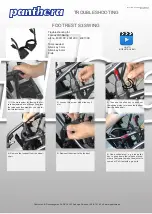
MOONLITE
13
ENGLISH
REACHING - BENDING BACKWARDS
DO NOT reach back any further than your
arm will extend without changing your sitting
position as this may affect your stability .
DO NOT lean over the top of the backrest as
it will shift the centre of gravity, risking tipping
over .
DO NOT hang heavy loads or objects on the
backrest . They may make the wheelchair
unstable, especially on an incline .
Assistive devices such as grab sticks can be
used to reduce the upper body movement .
Contact your healthcare specialist for further
details .
Body weight proportions:
Upper torso weight and height, lower limb
amputation, obesity, asymmetrical body
positions (leaning to one side) and muscle
spasms may affect stability .
Operating environment:
Hills, slopes, ramps, sloping pavements,
dropped kerbs also affect stability, especially
if contact is made with small obstacles on slopes
or hitting obstacles . Sloping surfaces should
never be attempted sideways . These can cause
the user to slide forwards or fall forwards out of
the wheelchair .
Accessories or other equipment:
Accessories generally affect the stability of the
wheelchair . Seat cushions raise the centre of
gravity and reduce the stability of the wheelchair
in all directions, backrest cushions will move the
centre of gravity forwards, which improves the
rearwards stability but reduces forward stability .
If you or your carer/attendant require further
advice about stability and its effects then
ask your healthcare professional, wheelchair
dealer, or wheelchair service for further
information.
If the wheelchair is to be transported unoccupied,
it may be stored as luggage whilst you are travelling
in a vehicle or a plane . The wheelchair may be folded
to reduce the space of the wheelchair . Ensure that
the wheelchair is properly secured to prevent it
moving during transit .
6.1 Lifting a wheelchair into the boot of a car (Fig. 18)
Where possible ask for assistance.
• It is recommended that any detachable parts are
removed before lifting the wheelchair
• The folded wheelchair (with footrests
detached, and wheels if applicable)
should be placed close to and
parallel with the car boot .
• The person should grip convenient
fixed parts of the wheelchair, one
hand well forward and the other well
back .
• Keeping their back straight the person should bend hips
and knees, straighten their legs and lift up the chair
(vertically) and balance it on the edge of the boot .
• With the weight taken by the wheels resting on the
edge of the boot, the chair should be tilted towards the
person; when nearly horizontal, it can be slid into the
boot .
6.2 Storage in a plane
•
Ensure that any detachable parts are secured with the
wheelchair or separately so they do not get lost during
loading and un-loading .
• Inform the airline you are travelling with and follow their
instructions with respect to transfer and loading of the
wheelchair from one location to another .
When the wheelchair is removed from storage or the
luggage area:
• Check that the wheelchair has not been damaged
during the transportation for example by other
unsecured luggage or objects falling onto the
wheelchair or by impact damage .
• Ensure that any detachable parts removed are replaced
when the wheelchair is put back into use .
Always follow the checklist in Section 7.1
before using your wheelchair to make sure
that it is functioning correctly.
6.3 Transportation of your wheelchair within a Vehicle
A wheelchair secured in a vehicle will not provide the
equivalent level of safety and security of a vehicle seating
system . Sunrise Medical recommends that the user
transfers to the vehicle seating and uses the vehicle-
installed restraint system wherever possible . Sunrise
Medical recognises that it is not always practical for the
user to be transferred and in these circumstances, where
the user must be transported whilst in the wheelchair, the
following advice must be followed:
Warnings:
The occupied wheelchair must be located in a forward
facing position and secured by the wheelchair tie down
and occupant restraint straps (WTORS tie downs
meeting the requirements of ISO 10542 or SAE J2249) in
accordance with the WTORS manufacturer’s instructions .
Refer to the section ‘Tie down Instructions’ for further
information on transporting your wheelchair .
6. Transporting your wheelchair
Fig. 18








































